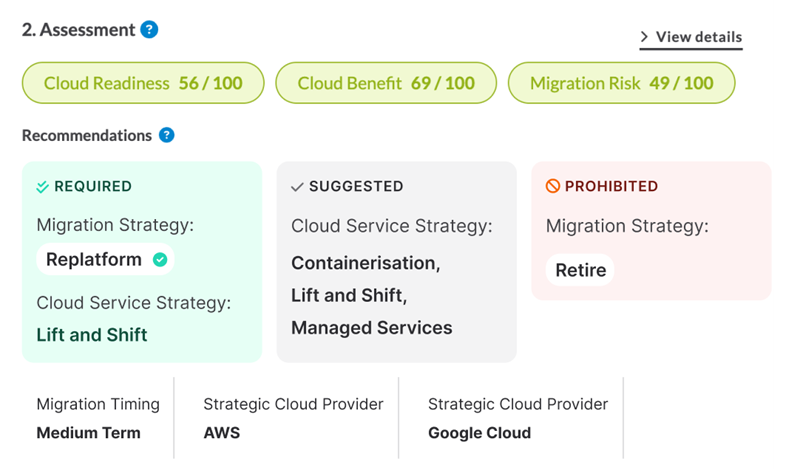5 reasons why your cloud transformation is not successful (yet)

For organizations that embarked on cloud transformation a few years ago, it's time to take stock. Did the cloud bring tangible benefits? Is the journey fully completed?
Some early (and heavy) adopters have already unlocked the full potential of cloud, and are now focusing on continuous portfolio modernization. Other organizations are “in between”: they have already migrated low-hanging fruits, and reaped some tangible benefits, but did not achieve full cloud value yet.
Finally, some organizations feel like something went wrong in the way, and that they got lost in the transformation process. Is this your situation? Then, read on!
In this troubleshooting article, we’ll discuss 5 typical reasons why a cloud transformation might go wrong, and see how to resolve the situation.
1 - You did not set clear goals at the beginning

The cloud has become increasingly popular in recent years. Therefore, many organizations have defined cloud computing as a must-have for their IT modernization roadmap. Indeed, cloud computing is a key building block for modernization. However, organizations should not decide to move to the cloud just because “it is state-of-the-art”.
Like every large-scale project, a cloud transformation needs a clear purpose to bear fruit. There are many paths to the cloud, and no path is per se better than another: It all depends on what your organization wants to achieve through cloud transformation. Is your main goal to save costs? To accelerate product development and shorten time-to-market? To experience improved scalability?
Your transformation goals will influence your migration decisions. If your priority is scalability, you will re-design your applications accordingly, and choose the relevant cloud pricing model. On the contrary, if your priorities are unclear, you will most likely base your decisions on short-term considerations, and go for the easiest (or cheapest) option.
Did you lack a strong vision at the beginning of your project? It is never too late to re-assess and build good foundations! In this whitepaper, we discuss how to align on a strong, common vision before starting your journey to the cloud.
2 - Your organization still lacks a strong cloud team

You have clear transformation goals, the main stakeholders are aligned on a common vision. And still, the transformation is not as straightforward as expected… Maybe you lack a strong team to foster cloud adoption across the entire organization?
Cloud transformation is a big change, and to fully embrace this change, teams need clear communication and close support. This includes:
- A well-prepared communication plan (at the beginning of the project, but also in the long term).
- Dedicated contact persons for any cloud-related questions.
- Training programs, especially for the IT department, but also for any member of the organization willing to develop a basic knowledge of cloud computing
A best practice in cloud transformation projects is to create a dedicated team, often called Cloud Center of Excellence. To learn more about the typical assignments of a Cloud Center of Excellence, have a look at our video on the topic:
3 - You relied a bit too much on lift-and-shift
There are different approaches to move an application to the cloud. A popular framework in this regard is the 6Rs of cloud migration created by Gartner. This model describes 6 migration (or retention) strategies, along with the advantages and disadvantages of each strategy.
One of these strategies is called rehosting, or lift-and-shift. In this approach, the organization creates a copy of an application, and replicates it in a cloud environment, without making significant changes to the application’s architecture and code.
As it allows a fast migration process, and does not require a lot of resources, lift-and-shift is often a preferred option for organizations that have a time constraint, or that don't have the resources to rework their current architecture in depth.
If, like many organizations, you saw lift-and-shift as a quick and easy pattern to achieve your cloud transformation, well you’re not completely wrong. Lift-and-shift can be a good first step, but it is often not the end of the cloud journey. As your applications were copied as-is, and not re-architected for the cloud, they do not allow you to leverage all the long-term benefits you can expect from a cloud modernization.
Do you want to achieve the full value of your cloud transformation? Then it might be time to go beyond lift-and-shift, and start a modernization process. The first step will be to re-assess your applications, and define which ones could be modernized as a priority.
4 - You got lost in cost comparison

Calculating the costs of your future cloud infrastructure is a tricky exercise. Not only do you have to take into account the cost of the cloud services, but also the cost of migration itself. For a complete cost analysis, you also need to consider cost avoidance (for instance, if your cloud infrastructure brings you higher protection against outages and other potential disasters).
Let’s say, as an example, that your company experiences consumption peaks every now and then, and that your main cloud migration goal is to have a scalable cloud infrastructure. With this goal in mind, you will probably pick an “on-demand” pricing model, as it enables more flexibility and, eventually, cost savings. However, if you focus on the direct costs only, you might opt for the cheapest cloud pricing model by default. This might indeed be cheaper in the short term, but it will not bring the benefits associated with scalability and elasticity.
If you want to learn more on cost comparison for cloud migration, have a look at our dedicated article.
5 - Your business-critical applications are not in the cloud yet

Many organizations start their cloud transformation by migrating “low-hanging fruit”: less critical applications that require low migration effort. They wait to be at a later stage of their cloud adoption journey to take care of more critical and more complex workloads.
Maybe you are in this situation: part of your application portfolio is already in the cloud, but the “core” infrastructure is not fully migrated yet.
In its 2023 report on Cloud Trends, Accenture states that one of the most common challenges for organizations is to achieve the full value of their cloud journey. Hence, many companies feel like they are in “cloud transformation limbo”. They are in the process of migrating “more complex and business-critical systems”, but “stubborn barriers remain”.
Migrating applications that have a high business value can lead to great benefits. But, because they are business-critical, their migration process is often more complex and risky. Here it is important not to shy away from related challenges and obstacles but to clearly understand the scope and address their migration process step by step.
Do you need support to start more complex cloud assessments?
On the way to modernize your lift-and-shifted applications? Ready to migrate business-critical applications? Then, the Txture platform is the tool you need!
With Txture’s Application Transformation Cockpit, you can easily collect information about your applications, and define their cloud readiness. Unlike other solutions, Txture considers not only the technical aspects of a migration, but also other criteria for a 360° assessment, including business criticality, security and compliance requirements, sustainability preferences, etc. Based on your specific needs, the platform provides your with migration recommendations for each application, as you can see below.
 The Txture platform provides a readiness score and migration recommendations for each application
The Txture platform provides a readiness score and migration recommendations for each application
Txture also comes with automated target architecture recommendations. You can compare several potential cloud architectures and define which one best fits your requirements.
Want to learn more about how we can help you speed up your cloud transformation? Reach out to us, we’ll be happy to answer any questions.
Related posts
5.4.2024Generative AIHow to welcome Generative AI into your existing tech ecosystem2.4.2024
Generative AIPaving the way for leveraging Generative AI in your organization8.1.2024
Cloud Business CaseCreate a compelling business case for cloud migration with Txture14.12.2023
Cloud MindsetThe Strategic Imperative of Adopting a Cloud-First Strategy29.11.2023
Cloud StrategyApplication rationalization - all you need to know

